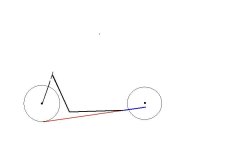John in CR
100 TW
There are several examples of leaning delta trikes where the rear wheels don't lean, but the rider and front wheel do lean like a normal bike. The ICE motorize Carver is one, and more recently and electric trike had a video posted in it's thread. For a long time I dismissed these trikes as probably unstable, but now I'm having second thoughts, primarily because implementation could be very simple.
No, it wouldn't enjoy the full handling benefits of a 3 wheel leaner, BUT if the connection to the leaning part of the trike and the motor, batteries, cargo weight between the 2 static wheels have a center of gravity below the axles of the rear wheels it should be extremely stable in turns.
Has anyone ridden one of these kind of trikes? Impressions? Problems I may not be seeing?
If the center of rotation to the leaning front part of the trike is horizontal, then those rear wheels would stay straight like in a car, however, if that center is angled down toward the front the rear wheels would turn too. I can see this as potentially being a real plus and could shorten the turning radius which would be especially helpful in low speed turns. I do worry about the effects and speed, especially in side winds. Anyone have input in this specific area?
John
No, it wouldn't enjoy the full handling benefits of a 3 wheel leaner, BUT if the connection to the leaning part of the trike and the motor, batteries, cargo weight between the 2 static wheels have a center of gravity below the axles of the rear wheels it should be extremely stable in turns.
Has anyone ridden one of these kind of trikes? Impressions? Problems I may not be seeing?
If the center of rotation to the leaning front part of the trike is horizontal, then those rear wheels would stay straight like in a car, however, if that center is angled down toward the front the rear wheels would turn too. I can see this as potentially being a real plus and could shorten the turning radius which would be especially helpful in low speed turns. I do worry about the effects and speed, especially in side winds. Anyone have input in this specific area?
John




